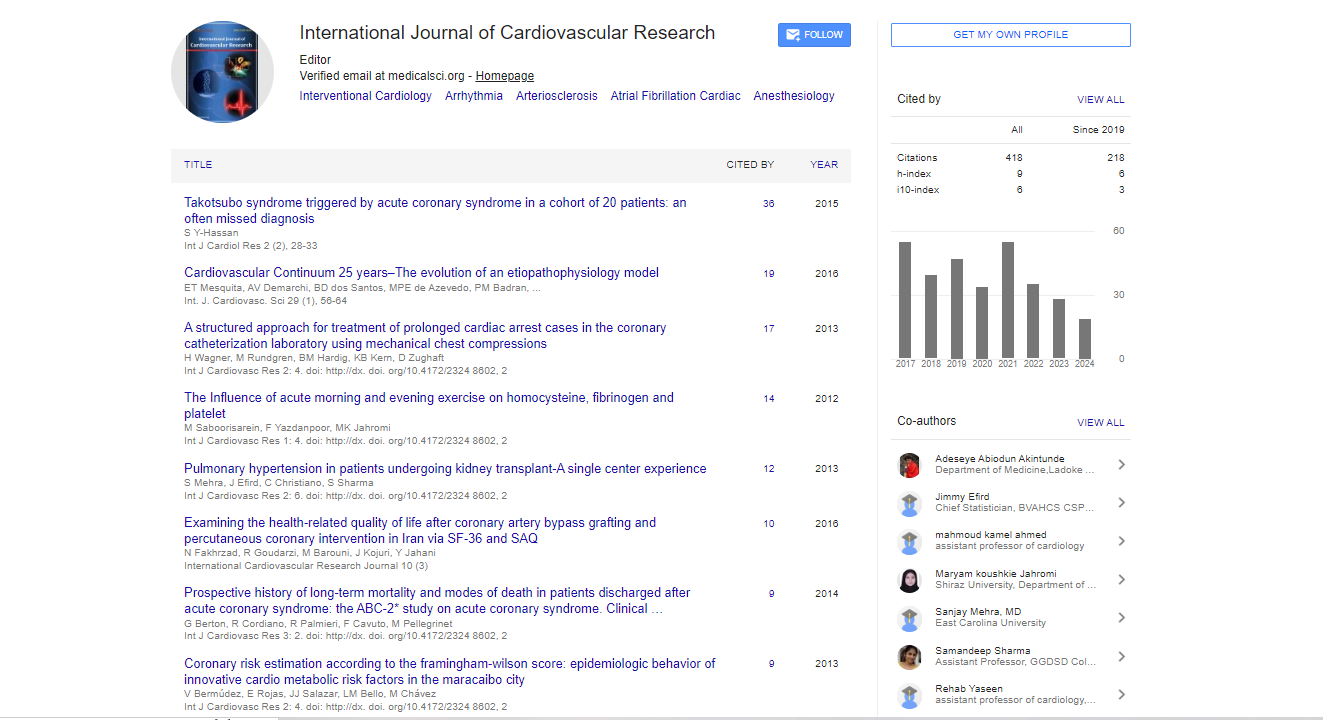Commentary, Int J Cardiol Res Vol: 13 Issue: 4
Heart Disease in Women: Gender-Specific Risk Factors and Treatment
William Davis*
1Department of Cardiovascular Medicine, Cleveland Clinic Lerner College of Medicine, Cleveland, United States of America
*Corresponding Author: William Davis,
Department of Cardiovascular Medicine,
Cleveland Clinic Lerner College of Medicine, Cleveland, United States of America
E-mail: william.davis@ccf.org
Received date: 15 July, 2024 Manuscript No. ICRJ-24-149294;
Editor assigned date: 17 July, 2024, PreQC No. ICRJ-24-149294 (PQ);
Reviewed date: 31 July, 2024, QC No. ICRJ-24-149294;
Revised date: 07 August, 2024, Manuscript No. ICRJ-24-149294 (R);
Published date: 14 August, 2024, DOI: 10.4172/2324-8602.1000577
Citation: Davis W (2024) Heart Disease in Women: Gender-Specific Risk Factors and Treatment. Int J Cardiol Res 13:4.
Description
Heart disease is the leading cause of death worldwide, affecting both men and women. However, it has long been perceived as a predominantly male condition, overshadowing the distinct ways in which heart disease manifests in women. Historically, women have been underrepresented in cardiovascular study and clinical trials, leading to a lack of gender-specific data and an underappreciation of the unique risk factors and presentations in women. Women face a range of gender-specific risk factors that affect both the development and outcomes of heart disease. Heart disease in women differs from men in terms of prevalence, risk factors, symptoms and outcomes. While men are more likely to develop Coronary Artery Disease (CAD) at younger ages, the risk in women increases after menopause and they are more likely to present with non-obstructive coronary disease, where smaller arteries are involved rather than large coronary blockages. Furthermore, women’s heart disease is often misdiagnosed or under-recognized due to atypical symptoms, resulting in delayed treatment and worse outcomes. Women tend to develop heart disease later in life than men, but once they do, they have a higher risk of severe complications, including heart failure and death. The mortality rates from cardiovascular disease are particularly alarming for women, as they often underestimate their personal risk, leading to late intervention.
Several unique risk factors predispose women to heart disease, some of which are exclusive to women or more prevalent in them than in men. These include biological factors related to hormones and pregnancy, as well as psychosocial and lifestyle factors. Estrogen plays a protective role in women’s cardiovascular health by maintaining the elasticity of blood vessels and promoting a favorable lipid profile. Before menopause, estrogen helps regulate vascular function and lowers the risk of developing coronary artery disease. However, after menopause, estrogen levels decline, leading to an increased risk of atherosclerosis and cardiovascular events. Postmenopausal women have an accelerated risk of heart disease, particularly when coupled with traditional risk factors like hypertension, obesity and diabetes. Hormone Replacement Therapy (HRT), once thought to reduce the risk of heart disease in postmenopausal women, has been shown in large trials to increase the risk of cardiovascular events, such as stroke and venous thromboembolism, particularly when initiated later in life. This has made the use of HRT controversial, requiring personalized risk assessments before initiation.
Pregnancy introduces several gender specific risk factors that can influence long-term cardiovascular health. Conditions like preeclampsia, gestational diabetes and pregnancy-induced hypertension are not only dangerous during pregnancy but also increase the likelihood of developing heart disease later in life. Women with a history of these complications have a higher risk of hypertension, diabetes and cardiovascular disease in their later years. Preeclampsia, in particular, is a strong predictor of future heart disease. It is associated with endothelial dysfunction, atherosclerosis and metabolic syndrome. These women require long-term monitoring and risk reduction strategies, such as lifestyle interventions and pharmacotherapy, to prevent the onset of cardiovascular disease after childbirth. Autoimmune diseases, such as Systemic Lupus Erythematosus (SLE) and Rheumatoid Arthritis (RA), are more prevalent in women and are associated with an increased risk of heart disease. These diseases cause chronic inflammation, which accelerates atherosclerosis and increases the risk of myocardial infarction and stroke. Women with autoimmune diseases are often under-recognized as high-risk cardiovascular patients, despite the growing body of evidence linking autoimmune conditions to early heart disease. Women are more likely than men to suffer from conditions like depression and anxiety, which have been linked to an increased risk of heart disease. Chronic psychosocial stress, including caregiving responsibilities and work-life balance challenges, can lead to harmful cardiovascular effects, such as high blood pressure, metabolic changes and inflammation. Depression, in particular, has been shown to be both a risk factor for and a consequence of cardiovascular disease, leading to a vicious cycle that exacerbates heart health in women.
Conclusion
Heart disease in women presents a complex challenge due to gender-specific risk factors, atypical symptoms and differential responses to treatment. Awareness of these gender differences is essential for clinicians to provide personalized care and improve outcomes in women with cardiovascular disease. As study continues to uncover the nuances of heart disease in women, the development of gender-specific diagnostic tools, treatment protocols and preventive strategies will be key to reducing the burden of heart disease in this population. By addressing the unique cardiovascular risks and needs of women, healthcare systems can make significant strides in closing the gender gap in heart disease outcomes.
 Spanish
Spanish  Chinese
Chinese  Russian
Russian  German
German  French
French  Japanese
Japanese  Portuguese
Portuguese  Hindi
Hindi 



